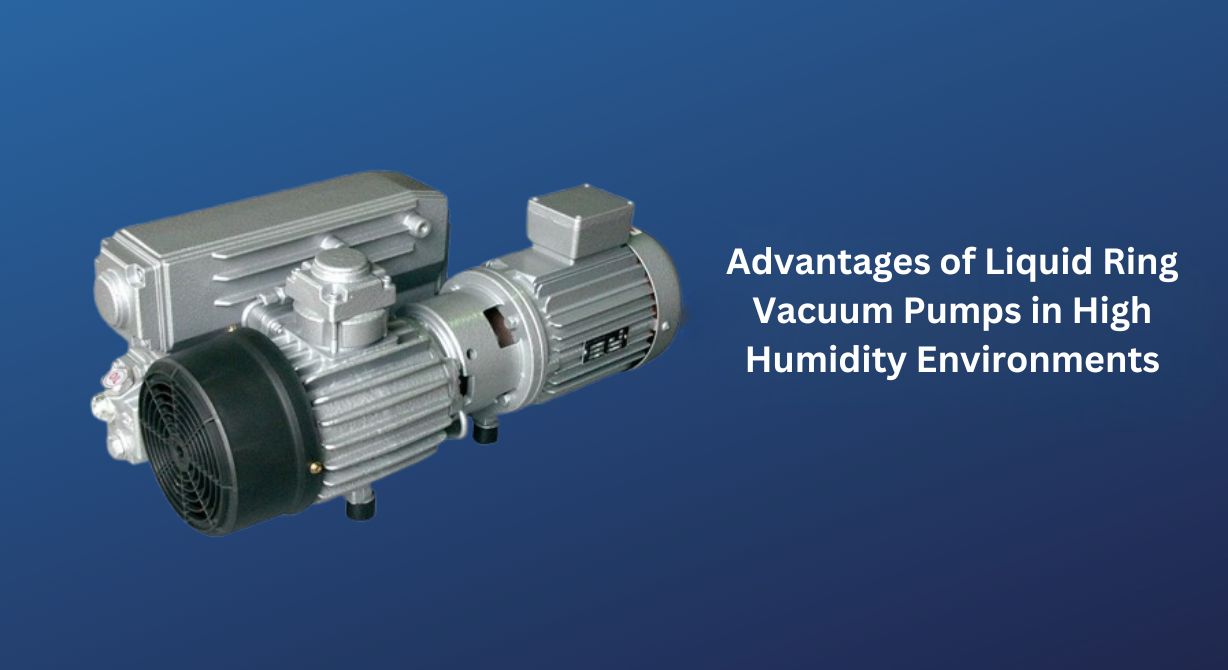Advantages of Liquid Ring Vacuum Pumps in High Humidity Environments
Table of Contents
- Why Liquid Ring Vacuum Pumps Excel in High Humidity Applications
- A Technical Guide to Selecting a Liquid Ring Pump for Wet Process Conditions
- Key Advantages of Liquid Ring Vacuum Pumps Over Dry Pumps in Humid Environments
- Liquid Ring vs. Rotary Vane Pumps: Which Performs Better with High Moisture Loads?
- How Liquid Ring Vacuum Pumps Handle Saturated Vapor and Condensable Gases
- Solving Humidity Challenges in Industrial Vacuum Systems: The Liquid Ring Solution
Why Liquid Ring Vacuum Pumps Excel in High Humidity Applications
In demanding industrial environments where process streams contain significant moisture or vapor, the selection of a vacuum pump becomes a critical engineering decision. Traditional dry pumps, such as rotary vane or claw-type pumps, face severe challenges when handling saturated vapors, often leading to rapid performance degradation and mechanical failure. Liquid ring vacuum pumps, by their fundamental operating principle, are uniquely suited to excel in these high humidity applications.
The core mechanism involves a multi-bladed impeller rotating within an elliptical casing partially filled with a sealing liquid, typically water. This rotation forms a stable liquid ring that acts as both the compressing element and a built-in heat exchanger. As the pump draws in gas-vapor mixtures, the incoming process gas is continuously cooled and condensed by the sealing liquid. This intrinsic condensation effect is a key advantage, as it dramatically reduces the actual volume of gas the pump must handle, leading to higher effective pumping speeds and lower energy consumption.
This design provides exceptional tolerance for entrained liquids and particulate matter, which would cause catastrophic damage to dry vacuum pumps. The constant flow of sealing fluid flushes the pump internals, preventing corrosion and the buildup of contaminants. This results in superior operational reliability and significantly reduced maintenance intervals compared to dry alternatives. For applications like vacuum distillation, solvent recovery, or wood drying, where the gas stream is largely composed of condensable vapor, this capability is indispensable.
Gücüm Pompa engineers its liquid ring vacuum pumps with a focus on optimizing this inherent robustness for harsh industrial duty cycles. The pumps are designed to maintain stable vacuum levels even with fluctuating inlet conditions, ensuring consistent process performance. The isothermal compression process minimizes the risk of vapor breakdown or polymerization, which is a common issue in hot, dry-compression pumps. This makes Gücüm Pompa's technology a commercially sound investment, reducing total cost of ownership through lower energy demands, minimal downtime, and extended service life in challenging environments.
Ultimately, the liquid ring vacuum pump is not merely a choice but a strategic solution for processes dominated by humidity. Its ability to handle wet gases directly, condense vapors in situ, and operate with simple, robust mechanics makes it the most reliable and economical technology for these specific duties. Gücüm Pompa's expertise ensures that these inherent advantages are maximized for critical operations across chemical, pharmaceutical, and food processing industries.
A Technical Guide to Selecting a Liquid Ring Pump for Wet Process Conditions
Selecting the appropriate vacuum technology for demanding wet process conditions is a critical engineering decision that directly impacts operational efficiency and total cost of ownership. The liquid ring pump stands as a robust solution, uniquely suited for environments laden with moisture, particulates, and condensable vapors. Its operational principle, which utilizes a rotating impeller within a ring of sealing liquid, provides inherent advantages in handling challenging process streams that would severely damage or clog dry pumping technologies.
The core operational principle of the pump involves creating a centrifugal liquid ring that acts as a series of moving pistons, compressing the gas. This design offers significant benefits, including isothermal compression, which minimizes the risk of vapor condensation within the pump itself. For applications such as distillation, evaporation, or filtration under vacuum, this characteristic is paramount for maintaining stable process conditions and ensuring consistent product quality. The choice of sealing liquid, often water or a specialized solvent, also allows for direct contact and condensation of process vapors, effectively scrubbing the gas stream.
When specifying a liquid ring pump from a manufacturer like Gücüm Pompa, engineers must carefully evaluate key performance parameters. Achieving the required ultimate vacuum level is essential, but so is understanding the pump's performance curve relative to the system's operating pressure. The pump's capacity, or air evacuation rate, must be matched to the gas load from the process, including any in-leakage or desorbed gases. Furthermore, the sealing liquid circuit design, including temperature control and filtration, is a critical subsystem that dictates long-term reliability and influences the overall energy consumption of the installation.
Beyond basic performance, the mechanical construction and material selection are vital for durability. Gücüm Pompa engineers pumps with materials resistant to corrosion and erosion, ensuring longevity even when processing aggressive media. The simplicity of the design translates to lower maintenance requirements compared to complex multi-stage dry pumps, reducing lifecycle costs. A well-selected liquid ring pump, therefore, is not merely a vacuum source but an integrated component for process reliability, acting as a crude knock-out pot and protecting downstream equipment from contamination.
Ultimately, the technical selection process is a balance of hydraulic performance, material compatibility, and system integration. A partnership with an experienced provider like Gücüm Pompa ensures access to engineering expertise for optimizing the entire vacuum system, from the pump itself to the vacuum system design of condensers and separators, guaranteeing peak performance in the most challenging industrial applications.
Key Advantages of Liquid Ring Vacuum Pumps Over Dry Pumps in Humid Environments
The fundamental operational principle of a liquid ring vacuum pump provides a distinct advantage in applications involving high moisture content or the potential for condensable gases. Unlike dry pumps, which rely on precise internal clearances and are highly susceptible to damage from liquid ingestion, the liquid ring design uses a sealing liquid, typically water, as the compression medium. This liquid inherently absorbs the heat of compression and condenses any vapors present within the pumping chamber, effectively managing the process load.
This intrinsic capability makes liquid ring pumps exceptionally robust for challenging environments. In processes like vacuum distillation, humid air extraction, or any application where vapor handling is critical, the pump transforms a potential problem—ingested moisture—into a core part of its function. The result is a highly reliable vacuum generation system with minimal risk of seizure or performance degradation due to saturated process streams, a common failure point for dry technologies.
Operational efficiency is another key differentiator. The isothermal compression process within a liquid ring pump avoids the extreme temperatures seen in dry pumps, which can promote the formation of sticky or corrosive deposits. This leads to significantly lower maintenance requirements and reduced operational costs over the pump's lifecycle. The simplicity of the design, often featuring a single rotating element with no internal metal-to-metal contact, further enhances its durability and reduces the need for specialized servicing.
For commercial decision-makers, the choice impacts total cost of ownership. While the initial energy consumption of a liquid ring pump may be a consideration, this must be weighed against the high cost of unscheduled downtime, frequent filter changes, and premature rotor failures common to dry pumps in wet conditions. The robust engineering of Gücüm Pompa's liquid ring vacuum pumps ensures continuous operation in these demanding scenarios, protecting your process integrity and bottom line.
Ultimately, the selection hinges on process conditions. In dry, clean-air applications, dry pumps excel. However, when humidity, vapor loads, or potential contamination are factors, the liquid ring vacuum pump is the technically and commercially superior solution. Gücüm Pompa's expertise in tailoring these systems with appropriate sealing fluids and configurations ensures optimal performance for specific industrial challenges, from chemical processing to food and beverage production.
Liquid Ring vs. Rotary Vane Pumps: Which Performs Better with High Moisture Loads?
The selection of an optimal vacuum pump technology is a critical decision in processes involving substantial water vapor or condensable gases, where high moisture loads can severely impact performance and reliability.
Rotary vane pumps, while efficient in dry applications, face significant challenges under these conditions. The primary issue is vane wear and potential seizure, as the operating fluid, typically a petroleum-based oil, becomes contaminated with water. This emulsification degrades lubrication and cooling properties, accelerating component failure and increasing maintenance frequency and cost.
In contrast, liquid ring pumps are inherently designed to handle wet gas streams. Their operation is based on a rotating impeller that creates a ring of sealing liquid, often water, which compresses the gas. This fundamental design makes them exceptionally robust against slugging and the ingestion of liquid droplets. The continuous flow of sealing liquid also provides integral gas cooling, condensing a significant portion of the vapor within the pump itself and protecting downstream components.
This intrinsic tolerance for moisture directly translates to superior operational stability in demanding environments such as vacuum distillation, paper mill suction rolls, and food processing. The design of a Gücüm Pompa liquid ring pump, for instance, emphasizes a large free space within the casing, allowing it to process gas streams with entrained liquids without damage, a feature critical for applications like environmental remediation.
While liquid ring pumps may have a lower nominal vacuum efficiency compared to a dry rotary vane pump, this is offset by their continuous, trouble-free operation in harsh conditions. The total cost of ownership is often lower due to reduced downtime and simpler maintenance. The choice, therefore, hinges not on peak performance in ideal settings, but on sustained reliability under the specific process conditions, making liquid ring technology the definitive choice for high moisture load applications.

How Liquid Ring Vacuum Pumps Handle Saturated Vapor and Condensable Gases
The operational principle of a liquid ring vacuum pump makes it uniquely suited for handling challenging gas streams containing saturated vapor and condensable components. Unlike dry pumps that risk damage from liquid formation, the liquid ring pump uses a working fluid, typically water, which acts as both the compression medium and a built-in condensation mechanism. As the gas mixture is drawn into the pump, it directly contacts the cooler seal liquid, initiating immediate condensation of the vapors within the pump chamber itself.
This intrinsic isothermal compression process is a critical advantage. The heat of compression is efficiently transferred to the seal liquid, preventing a significant temperature rise that would keep vapors in a gaseous state. This controlled environment allows condensable gases to change phase, dramatically reducing the actual volumetric flow rate that the pump must handle and protecting the pump's mechanical components. The design from Gücüm Pompa ensures a stable vacuum level even with fluctuating vapor loads.
For applications involving large quantities of moisture or solvents, a liquid ring vacuum pump often functions as its own direct-contact knock-out condenser. The condensed liquids become part of the seal fluid, which is continuously circulated and cooled through an external heat exchanger. This closed-loop system maintains the pump's efficiency and temperature stability, making it ideal for processes like distillation, vacuum drying, and evaporation where condensable vapors are the primary extraction stream.
The robust nature of these pumps translates directly into operational reliability and lower total cost of ownership. By tolerating the ingestion of liquid carry-over and condensing vapors internally, they eliminate the need for complex and expensive upstream separation equipment. Gücüm Pompa's engineering focus on durable construction and efficient gas compression ensures long service intervals and minimal maintenance, even in the harshest industrial environments. This makes them a commercially astute choice for chemical processing, pharmaceuticals, and food production.
Ultimately, the ability to manage two-phase flows is a defining characteristic. The continuous seal liquid circulation provides a self-cleaning action, preventing fouling and corrosion that would plague other vacuum technologies. This inherent capability to handle saturated vapor and condensables securely positions liquid ring pumps as a versatile and dependable solution for critical industrial vacuum applications.
Solving Humidity Challenges in Industrial Vacuum Systems: The Liquid Ring Solution
In industrial processes requiring robust vacuum generation, managing condensable vapors, particularly water vapor, presents a significant engineering challenge. Traditional dry vacuum pumps, while efficient in handling dry gases, are highly susceptible to performance degradation and mechanical failure when exposed to high humidity levels. The condensation of vapor within the pump's internal chamber can lead to corrosion, sludge formation, and catastrophic seizure, resulting in unplanned downtime and costly repairs. This fundamental limitation necessitates a vacuum technology inherently designed for wet gas streams.
The liquid ring vacuum pump stands as a premier solution for these demanding applications. Its operational principle is elegantly simple: a multi-bladed impeller rotates within an elliptical casing partially filled with a sealing liquid, typically water. This rotation forms a stable liquid ring that acts as both the compressing element and a built-in condensation mechanism. As the process gas, laden with vapor, is drawn into the pump, it comes into direct contact with the cooler sealing liquid. This intimate contact causes the vapor to condense immediately upon entry, effectively managing the gas load and preventing any damaging liquid from reaching the compression stage.
This intrinsic design offers profound advantages for system reliability and operational efficiency. The continuous circulation of the sealing fluid provides a constant cooling effect, maintaining a low operating temperature that is ideal for handling saturated streams. Furthermore, the pump possesses a high tolerance for contaminants, as particulates and even small amounts of aggressive liquids are often flushed away with the sealing medium, reducing wear and extending service intervals. This makes the technology exceptionally suited for harsh environments where process reliability is paramount.
Gücüm Pompa engineers have refined this technology to excel in specific industrial contexts. In chemical processing, for instance, their pumps safely handle solvents and vapors from distillation and evaporation units. Across the food and pharmaceutical industries, they provide dependable vacuum for dehydration and drying processes where product quality is directly linked to precise humidity control. The isothermal compression characteristic of liquid ring pumps also minimizes the risk of damaging temperature spikes when compressing flammable or sensitive gases. This focus on robust engineering design ensures that Gücüm Pompa's solutions deliver consistent vacuum performance under the most challenging conditions, safeguarding both the process and the equipment investment.

